Tarpon are one of the most challenging game fish to land, and learning how to catch tarpon is often an angler’s lifelong journey. Just when you think you’ve got them figured out, the bite shuts down and you’re left scratching your head. You can learn all the tips and tricks in the book, but perhaps the most important part of tarpon fishing is knowing where to be at the right time.
Tarpon are best known for their acrobatic jumps, but in order to experience the thrill of jumping a tarpon, you need to know where to find them. Florida presents some of the best tarpon fishing destinations in the world. Depending on the time of the year, tarpon can be caught in large numbers in the Keys, Miami, Boca Grande, and around Tampa. The East coast also offers solid fishing. And if you’re looking for a bigger adventure, Tarpon can be found off the coast of Central and South America as well.
Regardless of where you’re fishing, tarpon are stubborn fish, and lures and baits that were working great one day may miss the mark on the next. Here are some of the best places to catch tarpon:
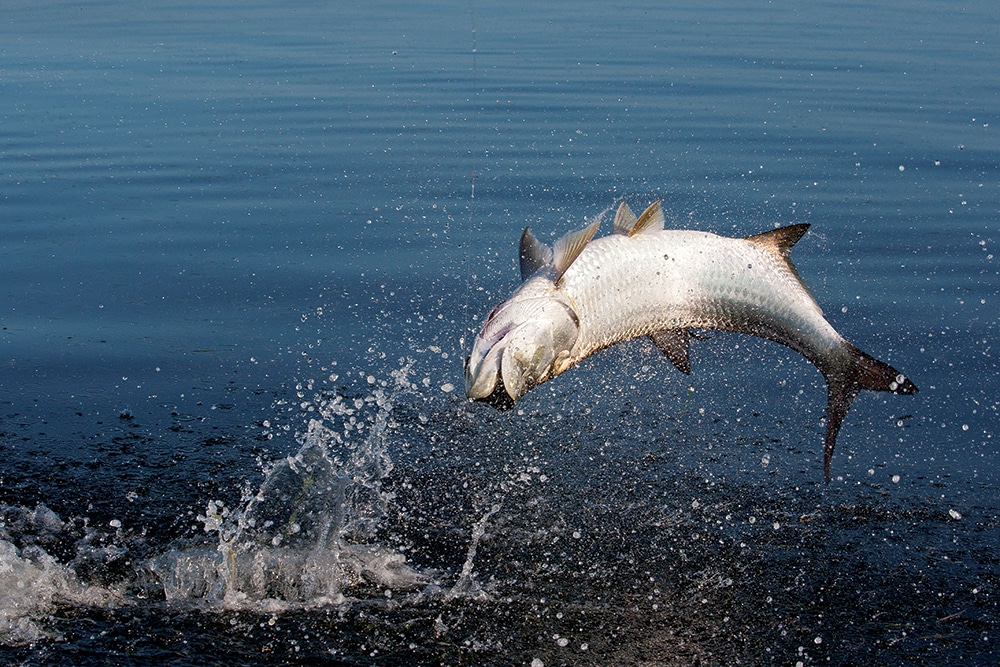
In Gulf states, Caribbean ports and even west African countries, anglers catch tarpon fever, affecting those across three continents during the prime season. The current world-record silver king, caught in Guinea-Bissau, weighed 286 pounds; angler Max Domecq landed the fish in 2003 with help from his full-time guide, a chap by the name of Patrick Sebile.
Whether in the East or West, warm Atlantic waters provide a slew of Megalops atlanticus hot spots, and in each location, pros employ different techniques to take down tarpon. Here, captains from five different regions reveal their techniques to rein in the silver king.
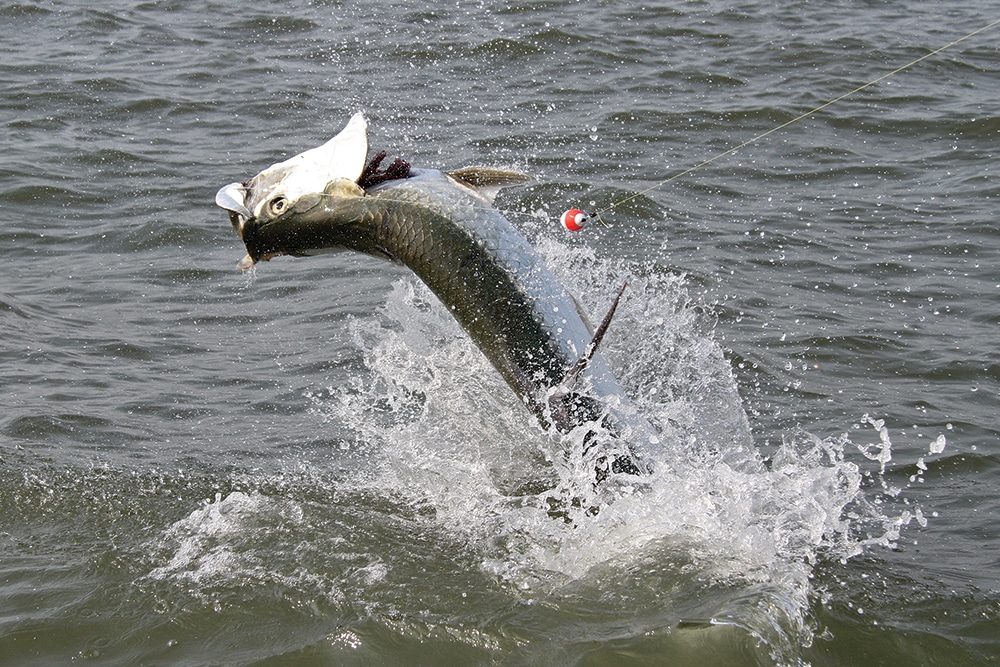
Hot on Top
Tarpon Fishing in South Carolina
Hot Season: Tarpon show from late June to October. After migrating here from Florida, they seem eager to attack a lure or live bait, especially in early July. An average tarpon weighs about 120 pounds.
Prime Habitat: Sand bars and structure around area inlets are the main structure, though broad inshore flats also hold tarpon. The waters provide opportunities for sight-fishing, live-baiting, lure-fishing and fly-fishing.
The Attraction: Tarpon feed on large schools of menhaden, mullet, shrimp and various bottomfish this time of year. Roff collects DNA samples of juveniles for the Bonefish & Tarpon Trust to help determine if local spawning occurs.
Fishy Structure: Any structure that creates a rapid change in water depth can potentially hold tarpon. Structure types in these waters include sand bars, inlet points, rocks and beach groins. A combo of bait, structure and moving tide helps anglers entice a bite. Summer months exhibit fairly clear, tannin-color water on the falling tide, providing several feet of visibility.

Hot on Top
The Approach: “Fishing a live bait on the surface underneath a float encourages amazing bites,” Roff says. “To see the ocean open up to a 130-pound tarpon tail-walking and greyhounding never gets old.” Spinning tackle packed with braid allows the angler to palm the spool for extra drag while fighting tarpon.
Tackle Up: Set up with 6 feet of 80- to 100-pound fluorocarbon leader attached to a slip float, terminating with a 7/0 or 8/0 circle hook. The main line must be at least 300 yards of 65-pound braid; high-viz line allows the angler to watch the line rise from the water and prepare for “air time.” Shorten the leader to 3 feet, and drop to 50- to 80-pound mono when casting lures such Rapala SubWalks, Hogy or D.O.A. lures. This helps keep the presentation looking as natural as possible but still allows an angler to pressure a tarpon.
Worthy Catch: Roff points out that he measures only a small fraction of the fish at boat-side; most often he’s concerned with pictures and a proper release. Last year he taped one fish to 73 inches fork length and 42 inches dorsal girth, estimating the fish at 172 pounds.
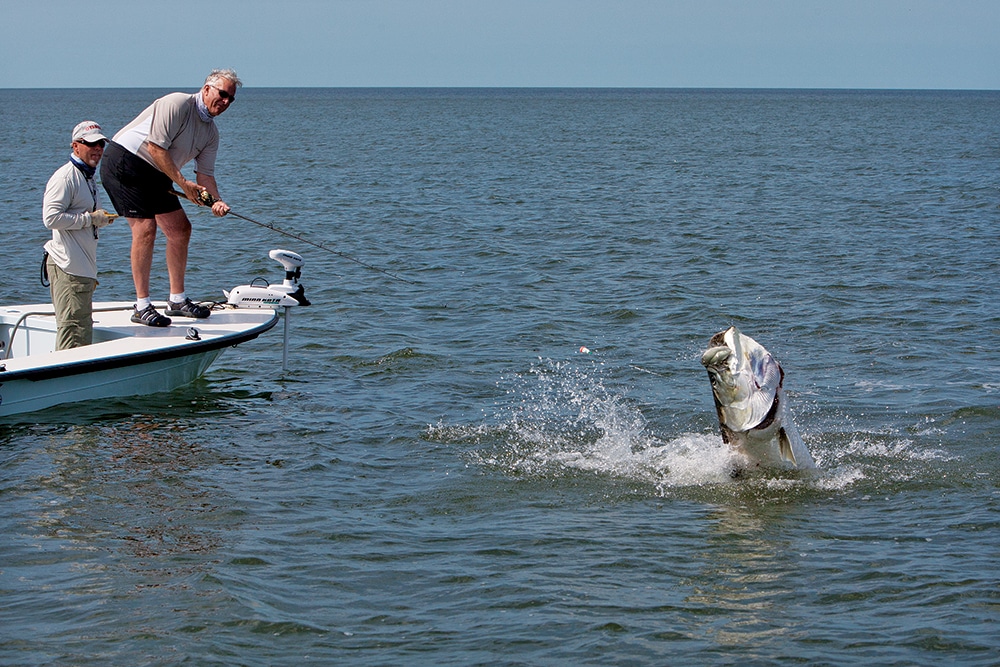
Go Heavy With Menhaden
Tarpon Fishing in Georgia
Hot Season: Tarpon show consistently by mid-June and hang around until the first week of October. July and August are the most consistent months, with fish averaging 80 pounds.
Prime Habitat: Coastal Georgia features miles of brackish rivers, salt marshes, inlets and bar systems. During the course of a season, tarpon can be found anywhere throughout this coastal system. Anglers must be flexible to scout deep channels, shallow bars, open sounds, inlets, flats, beaches, tide lines and offshore areas.
The Attraction: Warm water temperatures during the Georgia summer attract large schools of menhaden, plus large tidal movements appeal to tarpon.
Fishy Structure: The area features sand bars, but not much structure otherwise. Tarpon aggregate in waters ranging from crystal clear to muddy, waiting opportunistically. “They are more difficult to catch on artificial lures in muddy water,” Burge says, “so I generally rely on live menhaden in this scenario.”
The Approach: Begin the day filling the livewell with large live menhaden, and then half a five-gallon bucket with dead ones. Fish with the liveys, and chum with the dead pogies. Due to large tides (6 to 9 feet), everything after catching bait depends on the stage of the tide. Sight-fish on the last of the incoming and first half of the outgoing, especially when throwing artificial lures. Other tidal phases utilize live bait, either drifting or on anchor. “I fish four baits: two under floats, one free-lined, and one with a 12-ounce lead,” Burge says. “I prefer to fish pods of fish that are not actively foraging.”
Tackle Up: Burge prefers 8-foot rods, in both spinning and conventional tackle. On the conventional setups, use 30-pound mono and 40-pound braid with the spinning gear. Top bait is the largest live menhaden in the well. For lure color, Burge is a big fan of chartreuse.
Worthy Catch: Little fishing pressure and fish happy to bite mean Burge has the opportunity to hook plenty of tarpon. Numbers aside, his biggest catch was 180 pounds.
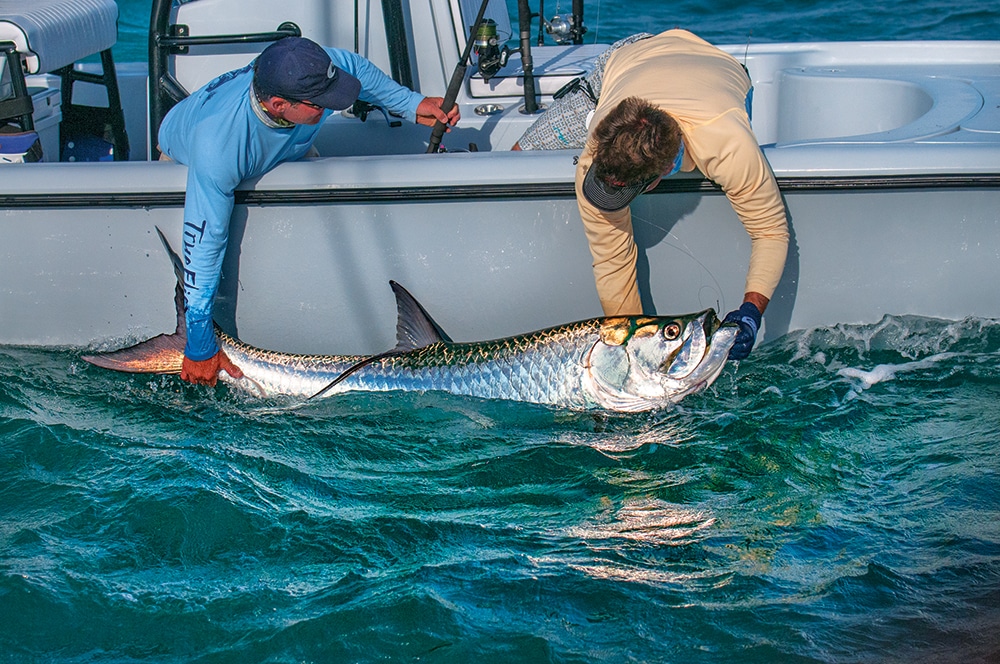
Set Your Sights
How to Catch Tarpon in Sarasota
Hot Season: West central and southwest Florida host tens of thousands of migratory adult tarpon during the late spring and summer months, mostly May through September.
Prime Habitat: Tarpon gather in large schools in the area’s bays, passes, and just off Gulf of Mexico beaches. They range from 50 to 200 pounds, with an average tarpon surpassing 100. In May, June and July, Wright primarily sight-fishes the Gulf, off the beaches, and around passes.
The Attraction: Wright believes that such large concentrations of big tarpon migrate to the area primarily for their annual spawning ritual. The strongest tides of the year occur on the last moon in May, the two moons in June and the two moons in July — which coincide with the biggest concentrations of tarpon.
Fishy Structure: Off the beach, hard-bottom areas hold schools of baitfish and therefore tarpon. When Wright fishes Gulf beaches and around the passes, the water is typically very clear. Clear water is a double-edged sword: It makes locating and staying on a school of fish easier, but it also allows tarpon to see the boat. Long accurate casts with the right bait are important.
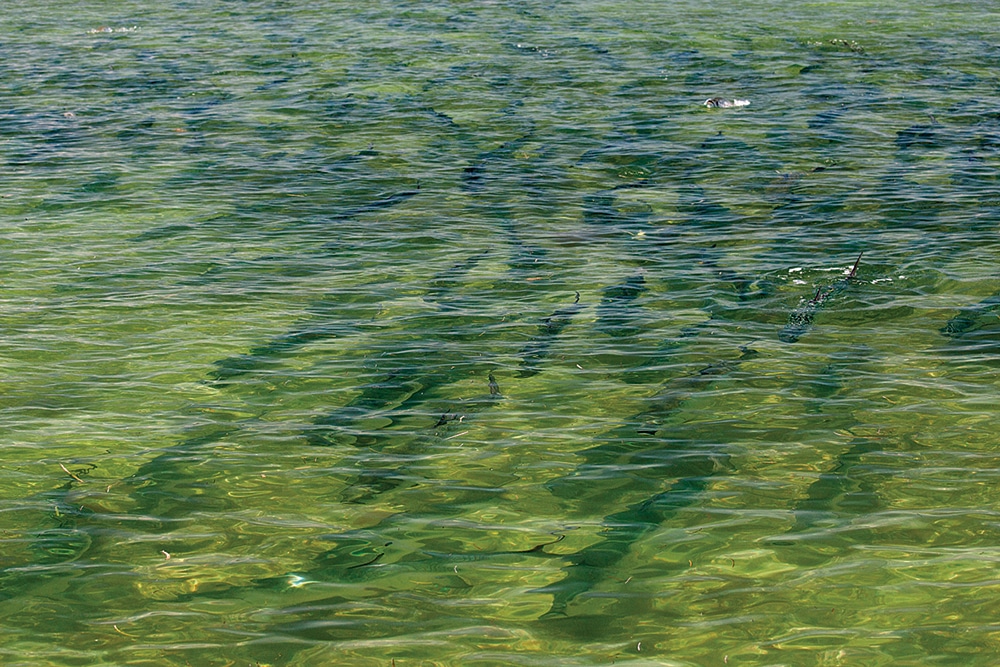
Set Your Sights
The Approach: Tarpon fishing here is a hybrid of fishing and hunting. Because tarpon gulp air at the surface, they provide great opportunities for sight-fishing in shallow water. Try to locate schools of fish away from boat traffic. If the fish are holding near the surface and moving slowly, put a float above a crab or baitfish to stay in the strike zone. For fish holding deeper, ditch the float and get the bait down. If the fish are greyhounding down the beach, chances are they’re not in a biting mood.
Tackle Up: For sight-fishing live baits such as blue crabs, threadfin herring, sardines and pinfish, Wright uses 8-foot fiberglass rods with big spinning reels that can handle 50-pound braid. The rod needs to have a lot of beef in the lower section, but a light tip capable of flinging baits distantly. Dead baits are better suited to conventional setups. Later in the season, he favors casting plugs such as MirrOlures. A medium-heavy graphite rod with a spinning reel rigged with 30-pound braid is the ticket.
Worthy Catch: The sheer volume of tarpon around in late spring and the summer months is a spectacle. Wright’s biggest fish topped 210 pounds, according to length and girth charts. He takes great care not to bring fish into the boat, and works to release healthy fish.
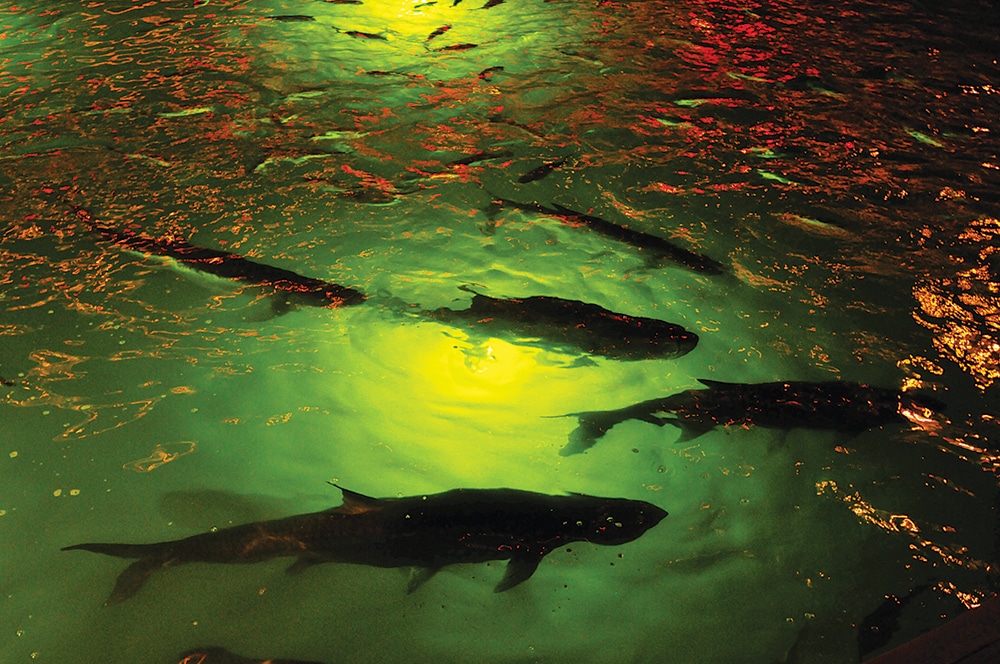
The Bridge Bite
How to Catch Tarpon in Miami
Hot Season: Tarpon hang around from January through May, trailing off after July.
Prime Habitat: Tarpon gather at Haulover Inlet and Government Cut in South Florida. Outside the cuts, they hang along the beach south of Haulover Inlet a mile and north of the jetty at Government Cut. Inside the inlets, a great urban tarpon fishery is available around the bridges after dark. Bridge tarpon range from 20 to 50 pounds.
The Attraction: Tarpon feed on runs of shrimp that occur each winter. In spring, mullet are the main baitfish, seconded by small crabs. The fish feed during the day or night, but at night, baits on the move during the tide change become easy pickings. Tarpon are less likely to see fishing line at night and therefore less wary when feeding.
Fishy Structure: At the inlets — besides the jetties themselves — the bottom ranges from sand to corals, soft and hard. In the deep waters of the main channel, there is a sheer ledge to contend with too. The bridges speak for themselves; be ready in the current (see Game Plan, page 10) to maneuver around pilings quickly.
The Approach: Based on the direction the wind’s blowing and tide’s flowing, Kostyo sets up a compatible drift along the beach. In the deep water of main channels, he gets baits down to the bottom with either a jig head or breakaway sinker. He marks the fish first on his recorder and gets up-tide or upwind of them, then drifts back through the fish. At the bridge, he anchors up-current of the shadow line and drifts baits back toward the pilings.
Tackle Up: Start with spinning or conventional gear, rigged with 20-pound line. Experienced anglers can drop down to 12-pound-test for a true challenge. At the bridges, to have a chance at landing tarpon, 30-pound braid is recommended. One top artificial bait is Gulp! Alive! Shrimp on a ¼- or ⅜-ounce jig head.
Worthy Catch: Kostyo’s biggest weighed 180 pounds, but he fought one much larger for two hours and never raised it more than 10 feet off the bottom.
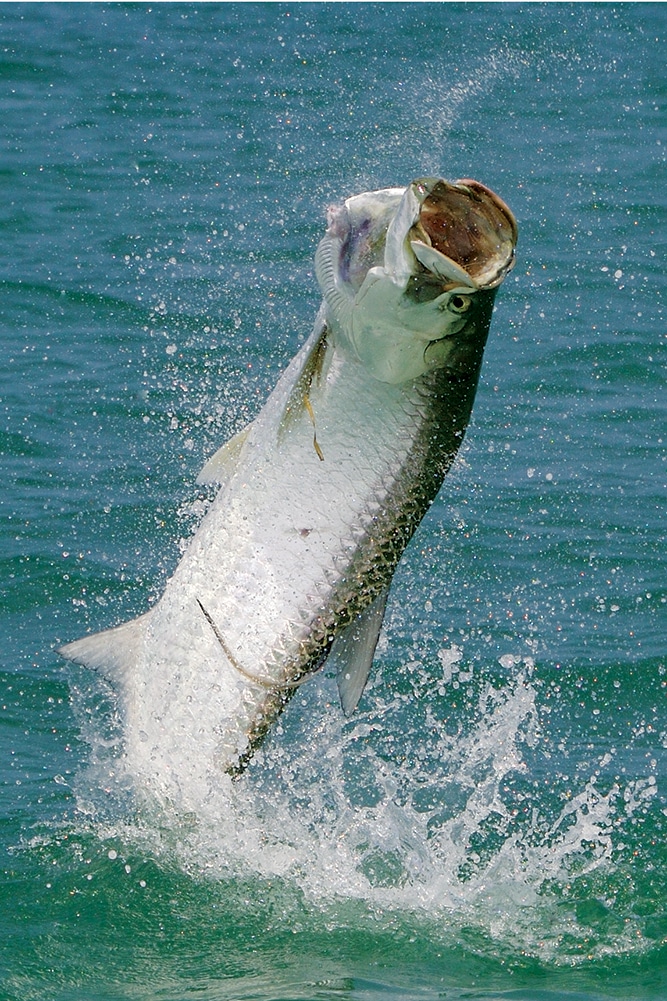
Fish the Bocas
Tarpon Fishing in Trinidad
Hot Season: Tarpon are caught year-round, with the main migration and season lasting May to November.
Prime Habitat: De la Rosa fishes deep channels, known as the bocas, between several islands that separate the Gulf of Paria from the Atlantic Ocean. Tarpon also run thick in the southern portion of the island, but due to logistics and an already abundant fishery in the north, he has not had to tap that fishery.
The Attraction: Tarpon chase the bait schools pushed into the area during the wet season. De la Rosa believes the fish also come to spawn in the area channels. Top live or dead bait is a ribbonfish; for artificials, a D.O.A. Swimming Mullet is the first option. Trinidad has only a handful of fishing operators and recreational tarpon anglers. Popular tarpon tournaments attract anglers from all over, such as this year’s Trinidad Tarpon Thunder Tournament in August.
Fishy Structure: Tarpon congregate around reef and rock near coastline of the islands.
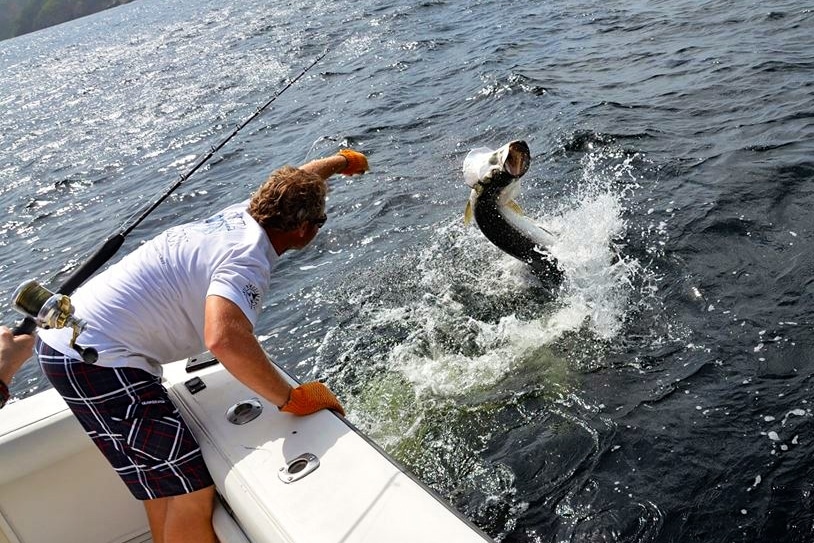
Fish the Bocas
The Approach: Trinidad tarpon are very sensitive to the tide. The best tidal stage to fish is the bottom of the tide until it maxes out at the top of the tide. The channels themselves experience heavy current on a falling tide, and only as the tide eases and starts to turn do the fish come off the bottom to feed. Water depths range from 30 to 200 feet, so sight-fishing is difficult; instead, De la Rosa drifts and looks for rollers. If big fish are busting, he goes straight to the conventional gear with the dead ribbons as bait.
“This adds a true element of big-game fishing, as the tarpon run into deep water,” he says. “Maneuvering the boat is required, almost as if backing down on a marlin.” When the bigger fish don’t cooperate, he uses live bait and spinning gear to target smaller sizes. The 15- to 60-pounders run in big schools, allowing anglers to release 10 to 20 tarpon in a four-hour session.
Tackle Up: Both conventional and spinning gear work. Shimano Talicas loaded with 80-pound braid joined to a top shot of about 30 to 40 yards of 80-pound mono handle dead ribbonfish with a 16/0 circle hook. The average fish caught on this setup weighs 100 to 180 pounds. For live baits such as Spanish sardines and herring, he prefers spinning reels capable of holding 350 to 400 yards of 50-pound braid. An 80-pound leader of 3 to 4 feet is paired with 5/0 to 7/0 circle hooks, depending on the bait size. “We use the spinning gear generally to target smaller fish, but the setups always end up getting bit by a giant,” he says.
Worthy Catch: De la Rosa believes he’s released fish as heavy as 200 to 230 pounds, with one monster taped at an estimated 250 pounds.








